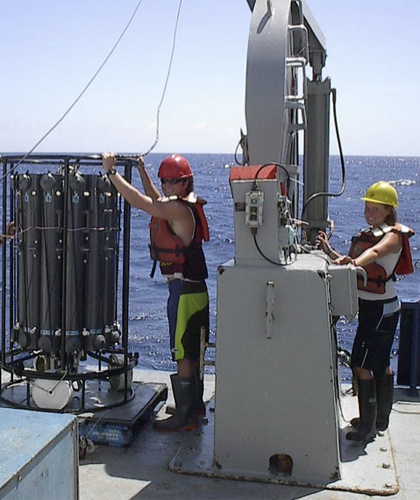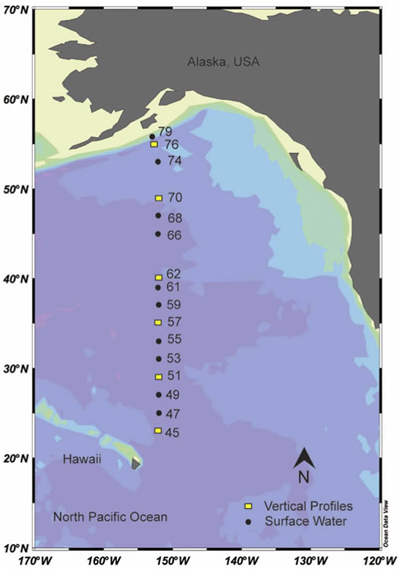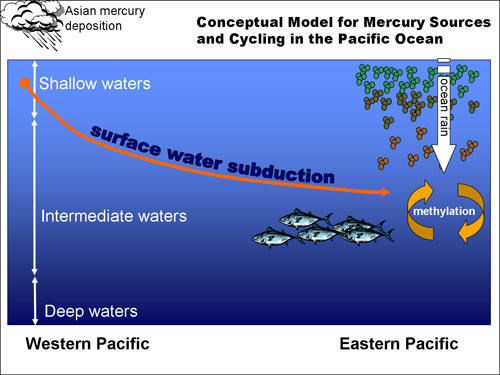Coastal and Marine Research:
 Mercury researchers globally have greatly improved our understanding of the environmental mercury cycle in freshwater settings. However, this improved understanding did not align well with the fact that the vast majority of human mercury exposure worldwide is due to the consumption of marine fish and shellfish. With this information in mind, the MRT began a concerted effort to initiate coastal zone and open-ocean studies to further our understanding of mercury cycling and fate in marine systems. In 2006, the MRT collaborated on study of the North Pacific Ocean (Sunderland et al., 2009), whereby samples were collected from Hawaii to Alaska. (http://toxics.usgs.gov/) The results from this study provided three paradigm-changing observations and established a new view of the and possibly other ocean basins around the globe. Those key observations are the following: (1) there is an open water mercury methylation process operating in the intermediate waters that is tied to the production of algae near the surface and later settle to depth where this organic material is degraded by microbial processes that lead to mercury methylation; (2) mercury deposition in the western Pacific ocean, which is significantly derived from emissions on the Asian continent, followed by lateral transport by large scale currents to the east and gradual sub subduction to greater depths “feeds mercury” to the zone of methylation; and, (3) Pacific Ocean mercury concentrations have increased by about 30% since the mid 1990’s, presumably due to increase emissions to air upwind masses. More recently, the MRT has collaborated on a study of the Bay of Fundy that describes the cycling of mercury in a coastal estuary (Sunderland et al., 2010) and suggest that embayments like this are mercury sinks but methylmercury sources. Last, in 2009 we collaborated on another open-ocean sampling effort, this time the southern Indian Ocean (samples taken from Cape Town, South Africa to Perth Australia. This study provides a nice opportunity to test whether open-ocean methylation is occurring in another major ocean basin, and how the rates of methylmercury production compare to the Pacific Ocean Study. Mercury researchers globally have greatly improved our understanding of the environmental mercury cycle in freshwater settings. However, this improved understanding did not align well with the fact that the vast majority of human mercury exposure worldwide is due to the consumption of marine fish and shellfish. With this information in mind, the MRT began a concerted effort to initiate coastal zone and open-ocean studies to further our understanding of mercury cycling and fate in marine systems. In 2006, the MRT collaborated on study of the North Pacific Ocean (Sunderland et al., 2009), whereby samples were collected from Hawaii to Alaska. (http://toxics.usgs.gov/) The results from this study provided three paradigm-changing observations and established a new view of the and possibly other ocean basins around the globe. Those key observations are the following: (1) there is an open water mercury methylation process operating in the intermediate waters that is tied to the production of algae near the surface and later settle to depth where this organic material is degraded by microbial processes that lead to mercury methylation; (2) mercury deposition in the western Pacific ocean, which is significantly derived from emissions on the Asian continent, followed by lateral transport by large scale currents to the east and gradual sub subduction to greater depths “feeds mercury” to the zone of methylation; and, (3) Pacific Ocean mercury concentrations have increased by about 30% since the mid 1990’s, presumably due to increase emissions to air upwind masses. More recently, the MRT has collaborated on a study of the Bay of Fundy that describes the cycling of mercury in a coastal estuary (Sunderland et al., 2010) and suggest that embayments like this are mercury sinks but methylmercury sources. Last, in 2009 we collaborated on another open-ocean sampling effort, this time the southern Indian Ocean (samples taken from Cape Town, South Africa to Perth Australia. This study provides a nice opportunity to test whether open-ocean methylation is occurring in another major ocean basin, and how the rates of methylmercury production compare to the Pacific Ocean Study.

|

